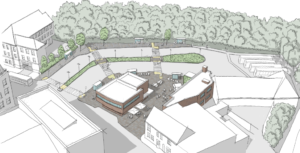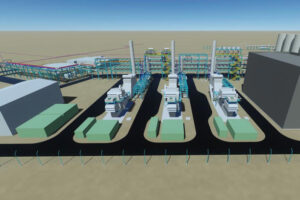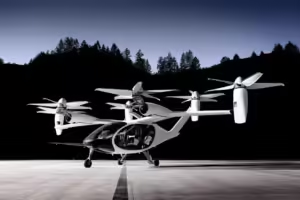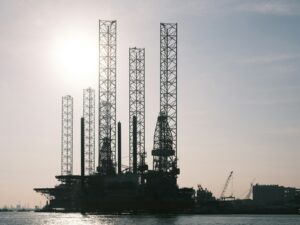Ford’s focus: building the city of tomorrow
The motoring giant Ford has launched a new team to work with local authorities to help shape the changing face of transport infrastructure. Ford’s City Solutions team is part of the international company’s vision for a ‘city of tomorrow’, which was unveiled last month at the North American International Auto Show by executive chair, Bill Ford. The team is believed to be only one of its kind in the automotive industry and will work with civic leaders around the world to develop and pilot projects to address issues like the advent of electric vehicles, pollution and congestion.
Environment Journal’s Jamie Hailstone spoke to Ford Smart Mobility’s director of city solutions, Jessica Robinson, about the company’s vision and the role civic authorities can play in shaping the city of tomorrow.
Why is a company like Ford interested in issues like infrastructure, congestion and the urban environment?
Ford is expanding its business to be both an auto and mobility company, while making people’s lives better by changing the way the world moves. For more than 100 years, Ford has been part of the community and the trusted source for automotive transportation. But it is clear that the transportation system we developed over the last 100 years will not work for the next 100. Half of the world’s population lives in cities, by 2030 that number is expected to grow by 60%.
As populations grow, we know that the challenges tied to moving people and goods will become tougher, and that is why we are focused on cities and delivering mobility solutions. We believe cities offer the greatest opportunities to solve the mobility paradox of reducing congestion while increasing capacity. Also, Ford believes mobility is an issue that goes beyond congestion. It is a massive challenge that affects our wellbeing and access to healthcare, clean drinking water, food, a safe place to live and even the ability to find work. By solving mobility challenges, we have the chance to create a better world for future generations.
How will the company’s new City Solutions team work to achieve this?
 Ford’s City Solutions team – the only one of its kind in the auto industry – is working with cities around the world to propose, pilot and develop mobility solutions to meet each city’s unique priorities and address its unique transportation challenges. Ford’s goal is to launch mobility services that take into consideration a city’s existing infrastructure and public services to develop smart, customised multimodal solutions and change the way the world moves.
Ford’s City Solutions team – the only one of its kind in the auto industry – is working with cities around the world to propose, pilot and develop mobility solutions to meet each city’s unique priorities and address its unique transportation challenges. Ford’s goal is to launch mobility services that take into consideration a city’s existing infrastructure and public services to develop smart, customised multimodal solutions and change the way the world moves.
For example, Ford acquired Chariot, an app-based crowd-sourced shuttle service with user defined routes and stops, which serves as the cornerstone for our new global shuttle business. Today, Chariot operates in San Francisco and Austin and is expected to expand to six additional markets by the end of this year, including at least one outside the United States In addition to our shuttle solution, Ford is also collaborating with Motivate bike share and working with city officials in San Francisco and the Bay area to provide more access to sustainable transportation options. The bikes will be branded Ford GoBikes and accessed through the FordPass app this spring. The FordPass app reinvents the customer experience and is a one-stop shop portal for consumers – whether you own a Ford vehicle or not to access transportation services and address mobility needs.
Additionally, Ford is beginning to collaborate with Bloomberg Philanthropies and its coalition of mayors worldwide. As part of this, we are discussing how we will work together to create the city of tomorrow and incubate ideas around mobility to accelerate solutions in the city.
Many modern cities are built around the car. How will the city of tomorrow be different in that respect?
Ford’s ‘city of tomorrow’ vision looks at how near-term mobility advancements – including autonomous and electric vehicles, ride-sharing and ride-hailing and connected vehicles – interact with urban infrastructure and create a transportation ecosystem. For example, Ford imagines a world in which reconfigurable roads fluidly respond to commuter needs and traffic flow. We believe there needs to be a system that integrates transportation services, payments and more into one operating system to deliver a seamless transportation experience for consumers.

Why is it important for civic leaders and local authorities it to start planning now for the technological changes, which will be coming in the next 20 years?
As urban populations continue to increase it is important to solve congestion issues and help people move more easily today and in the future. We believe that cities are going to undergo a transition over time where more and more things are connected. Through connectivity, you can begin to manage the system more efficiently in the city of tomorrow. Cities themselves will need to collaborate with information and mobility providers to provide successful mobility services and to build out solutions.
Will municipal authorities need to play a much more proactive role in managing traffic and congestion?
No one city or mobility provider can solve these mobility issues alone. It is important that Ford and others, work together with governments and other partners to provide solutions and address transportation challenges that are unique to each market.
How are public transport systems likely to evolve?
Today, most transportation services operate individually. We believe that in the future, you will see not only services and transportation options connect to each other, but also connected with cities and their infrastructure to deliver more personalised and efficient services and experiences with consumers.
What the traffic management systems of tomorrow look like? Will they be able to interact with vehicles and what will the benefits of this be?
In Ford’s vision for the future, there will be connected communications between vehicles and infrastructure. Vehicles will be capable of connecting with other vehicles and cities’ transportation operating systems. As these vehicles and other connected vehicles are introduced into cities around the world, cities themselves will change such as large scale innovations, like wireless charging and enhanced connectivity. These changes could give city transportation managers all-new operating systems which allow them to manage multiple aspects of their city transportation system centrally, including traffic flow and vehicle emissions.
Can traffic management systems and technology also be used to improve air pollution and other issues?
Yes, we believe that reducing congestion and vehicle emissions will improve traffic flow and air pollution.
What other improvements do you see coming down the line, particularly in regard to electric and autonomous cars?
In the next five to 10 years, we see the introduction of autonomous vehicles, growth of electrified vehicle, proliferation of connected vehicles and devices and new infrastructure technology combining to begin to make transportation more affordable and cities healthier, easier to navigate, safer and more productive. In the long-term future – 30 or more years out – we see large scale implementation of these technologies and sophisticated operating systems connecting them to result in things not previously thought possible such as significant reduction in emissions, traffic accidents near zero, and universal access to mobility.
Will the advent of drone technology inevitably mean we will have fewer cars on the road?
Drones will play many roles for mobility in the future. For example, they could quickly be deployed to survey and map the hardest hit areas following earthquakes, tsunamis or other major disasters. We also believe that drones will provide those last-mile solutions for the movement of goods. The last mile describes the mobility challenges one faces in the final leg of their commute or travel.
In the long term, will we see road space and land, traditionally used by cars and other vehicles, converted into more green space? How much land could be released?
In the long term future, Ford sees that mass transit will improve for cities with new technologies like advanced high-speed public transit and there are possibilities for converting road space into green space and parks, allowing for higher quality of life and healthier communities.
And finally, will all these innovations mean we can finally say goodbye to rush hour traffic jams?
In the long term future, we see large-scale implementation of advanced technologies for flexible traffic management coupled with autonomous vehicles, could eliminate traffic jams, reducing emissions and bringing traffic accidents to nearly zero.















